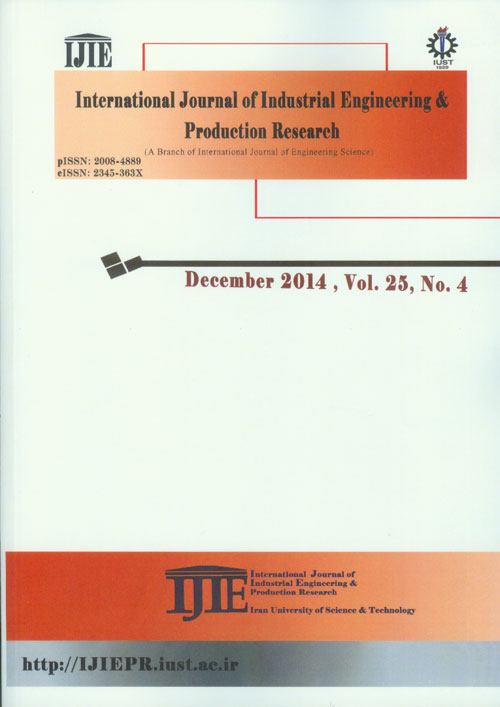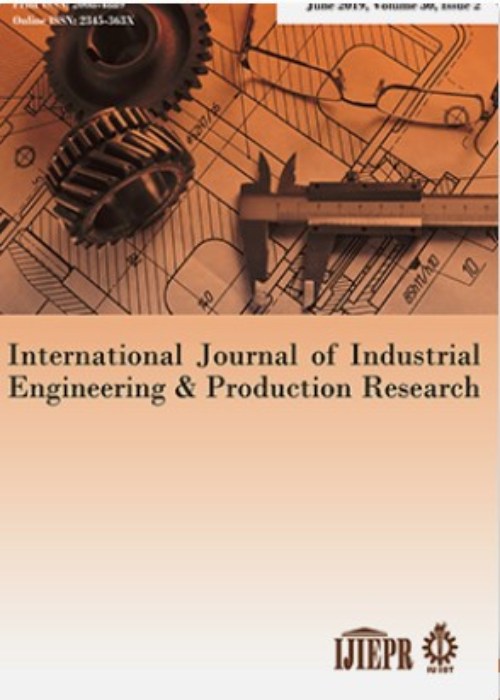فهرست مطالب

International Journal of Industrial Engineering and Productional Research
Volume:25 Issue: 4, Dec 2014
- 80 صفحه،
- تاریخ انتشار: 1393/10/10
- تعداد عناوین: 6
-
-
Page 257The Weibull distribution has been widely used in survival and engineering reliability analysis. In life testing experiments is fairly common practice to terminate the experiment before all the items have failed, that means the data are censored. Thus, the main objective of this paper is to estimate the reliability function of the Weibull distribution with uncensored and censored data by using Bayesian estimation. Usually it is assigned prior distributions for the parameters (shape and scale) of the Weibull distribution. Instead, we assign prior distributions for the reliability function for a fixed time, that is, for the parameter of interest. For this, we propose different non-informative prior distributions for the reliability function and select the one that provides more accurate estimates. Some examples are introduced to illustrate the methodology and mainly to investigate the performance of the prior distributions proposed in the paper. The Bayesian analysis is conducted based on Markov Chain Monte Carlo (MCMC) methods to generate samples from the posterior distributions.Keywords: Bayesian, maximum, likelihood, Weilbull, prior distribution, copula, reliability function, Jeffreys, reference, MCMC
-
Page 269Because of electricity subsidies, electricity price in Iran is much lower than its real value, and the growth of electricity demand is much more than its rational rate, which in turn implies ever increasing investment in the electricity section by the Government. Therefore, the recent Government policies are based on elimination of electricity subsidies, followed by commissioning complete electricity market to attract investors in the power industry. In this paper, a model is developed for electricity demand prediction and evaluating Iran's current electricity market and complete market to deal with optimistic and pessimistic electricity demand. Hence, a system dynamics framework is applied to model and generate scenarios because of its physical capability and information flows that allow understanding the of behavior nonlinear dynamics in uncertain conditions. To validate the model, it was compared with the available actual data within 21 years, since (1988-2008). After model validation, two scenarios are evaluated based on the influence of eliminating electricity subsidies on electricity demand in short-term and long-term and then commissioning of the probable complete electricity market is evaluated. For this purpose, first, the electricity demand is estimated for the target years and then changing dynamics in transition of Iran’s electricity market is analyzed.Keywords: System dynamics, Electricity market, Electricity subsidies
-
Page 287Customer service level is of prime importance in today competitive world and has various dimensions with delivery quality being one of the most important ones. Delivery quality has several parameters such as deliver time window options, time window size, etc. In this paper we focus on one of these parameters, namely time window setting. It has a direct impact upon customer satisfaction and business profit. On the other hand, delivery time windows affect routing and distribution costs. Generally, in the routing operation, time windows have been determined by customers or distributer and are considered as input parameters for the vehicle routing problem with time window (VRPTW) model. In this paper, a mathematical model is proposed for the integration of these two decisions; in other words, in the present model, time window setting decisions are integrated with routing decisions. Then a column generation approach is employed to obtain the lower bounds of problems and to solve the problems, a quantum algorithm is proposed. Finally, the computational results of some instances are reported and the results of these approaches are compared. The results demonstrate the effectiveness of the quantum algorithm in solving this problem.Keywords: Time window setting, Vehicle routing problem, Column generation, Quantum algorithm
-
Page 297Today, companies need to make use of appropriate patterns such as supply chain management system to gain and preserve a position in competitive world-wide market. Supply chain is a large scaled network consists of suppliers, manufacturers, warehouses, retailers and final customers which are in coordination with each other in order to transform products from raw materials into finished goods with optimal placement of inventory within the supply chain and minimizing operating costs in the face of demand fluctuations. Logistics is the management of the flow of goods between the point of origin and the point of consumption. One issue in Logistics management is the presence of possible long delays in goods transportation. In order to handle long delays, there are two possible solutions proposed in this paper. One solution is to use Model Predictive Controllers (MPCs) using orthonormal functions (Laguerre functions) and the other is to change supply chain model in which an integrator is imbedded. To this end, the two mentioned solutions will be implemented on a supply chain with long logistics delays and the results will be compared to classical MPC without using orthonormal basis and augmented model for different type of customer demand (constant, pulse and random demand).Keywords: Logistics, delay, Model Predictive Control, Orthonormal functions, supply chain
-
Analyzing the Effect of Organizational Strategies on Organizational results using system dynamics based upon EFQM modelPage 307In order to evaluate the relationship between Organizational Strategies and Organizational results, a comprehensive model is required, which should be able to capture all aspects of business excellence. The EFQM model is suitable tool to observe these factors. The EFQM model consists of two main domains: Enablers and Results. The first domain which includes processes and systems in general, "enable" the organization to have higher performance or "results". On the other hand, the feedback from the results makes the organization to correct the system. Hence, a dynamic model could be appropriate in analyzing the interrelated behavior of the two main domains as well as those within the criteria and sub-criteria. This research is an effort to find the relationship between Strategies and results through system dynamics tool based upon EFQM model. In other words, this research exploits system dynamics in order to measure the effects of Strategies on Organizational results using a dynamic model. The advantage is that by changing one parameter in the Strategies, one can find how it could affect key results especially financial outcomes. Keywords: Organizational Strategies, Organizational results, Business Excellence Model, EFQM, System Dynamics.Keywords: Organizational Strategies, Organizational results, Business Excellence Model, EFQM, System Dynamics
-
Page 317Hub location-allocation problems are currently a subject of keen interest in the research community. However, when this issue is considered in practice, significant difficulties such as traffic, commodity transportation and telecommunication tend to be overlooked. In this paper, a novel robust mathematical model for a p-hub covering problem, which tackles the intrinsic uncertainty of some parameters, is investigated. The main aim of the mathematical model is to minimize costs involving: 1) the covering cost; 2) the sum of the transportation costs; 3) the sum of the opening cost of facilities in the hubs; 4) the sum of the reopening cost of facilities in hubs; 5) the sum of the activating cost facilities in hubs; and 6) the sum of the transporter's purchasing cost. To solve this model, use has been made of the new extensions to the robust optimization theory. To evaluate the robustness of the solutions obtained by the novel robust optimization approach, they are compared to those generated by the deterministic mixed-integer linear programming (MILP) model for a number of different test problems. Finally, the conclusions are presented.Keywords: Hub covering problem, Facilities location, Opening, reopening modes, Transporter vehicle, Robust approach


